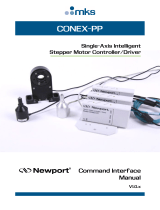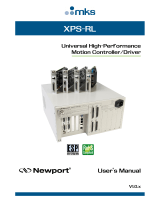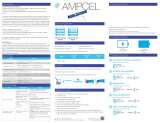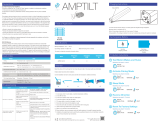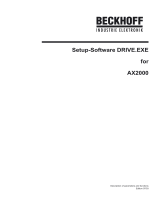Page is loading ...

ESP300 Motion Controller/Driver
User's Manual

Warranty
Newport Corporation warrants that this product will be free from
defects in material and workmanship and will comply with Newport’s
published specifications at the time of sale for a period of one year from
date of shipment. If found to be defective during the warranty period,
the product will either be repaired or replaced at Newport's option.
To exercise this warranty, write or call your local Newport office or
representative, or contact Newport headquarters in Irvine, California.
You will be given prompt assistance and return instructions. Send the
product, freight prepaid, to the indicated service facility. Repairs will
be made and the instrument returned freight prepaid. Repaired
products are warranted for the remainder of the original warranty
period or 90 days, whichever first occurs.
Limitation of Warranty
The above warranties do not apply to products which have been
repaired or modified without Newport’s written approval, or products
subjected to unusual physical, thermal or electrical stress, improper
installation, misuse, abuse, accident or negligence in use, storage,
transportation or handling. This warranty also does not apply to fuses,
batteries, or damage from battery leakage.
THIS WARRANTY IS IN LIEU OF ALL OTHER WARRANTIES,
EXPRESSED OR IMPLIED, INCLUDING ANY IMPLIED
WARRANTY OF MERCHANTABILITY OR FITNESS FOR A
PARTICULAR USE. NEWPORT CORPORATION SHALL NOT
BE LIABLE FOR ANY INDIRECT, SPECIAL, OR
CONSEQUENTIAL DAMAGES RESULTING FROM THE
PURCHASE OR USE OF ITS PRODUCTS.
First printing 1999
Copyright 2002 by Newport Corporation, Irvine, CA. All rights
reserved. No part of this manual may be reproduced or copied without
the prior written approval of Newport Corporation.
This manual has been provided for information only and product
specifications are subject to change without notice. Any change will
be reflected in future printings.
2002 Newport Corporation
1791 Deere Ave.
Irvine, CA 92606
(949) 863-3144
P/N 28187-02 Rev. F
ii Preface

Confidentiality & Proprietary Rights
Reservation of Title:
The Newport programs and all materials furnished or produced in
connection with them ("Related Materials") contain trade secrets of
Newport and are for use only in the manner expressly permitted.
Newport claims and reserves all rights and benefits afforded under
law in the Programs provided by Newport Corporation.
Newport shall retain full ownership of Intellectual Property Rights in
and to all development, process, align or assembly technologies
developed and other derivative work that may be developed by
Newport. Customer shall not challenge, or cause any third party to
challenge the rights of Newport.
Preservation of Secrecy and Confidentiality and Restrictions to
Access:
Customer shall protect the Newport Programs and Related Materials
as trade secrets of Newport, and shall devote its best efforts to ensure
that all its personnel protect the Newport Programs as trade secrets of
Newport Corporation. Customer shall not at any time disclose
Newport's trade secrets to any other person, firm, organization, or
employee that does not need (consistent with Customer's right of use
hereunder) to obtain access to the Newport Programs and Related
Materials. These restrictions shall not apply to information (1)
generally known to the public or obtainable from public sources; (2)
readily apparent from the keyboard operations, visual display, or
output reports of the Programs; 93) previously in the possession of
Customer or subsequently developed or acquired without reliance on
the Newport Programs; or (4) approved by Newport for release
without restriction.
Service Information
This section contains information regarding factory service for the
ESP300 System. The user should not attempt any maintenance or
service of the system or optional equipment beyond the procedures
outlined in this manual. Any problem that cannot be resolved should
be referred to Newport Corporation.
Preface iii

ESP300
1999
EU Declaration of Conformity
iv Preface

Table of Contents
Warranty ............................................................................ ii
Limitation of Warranty ....................................................... ii
Copyright ............................................................................ ii
EU Declaration of Conformity........................................... iv
Section 1 – Introduction ...........................................1-1
1.1 Scope............................................................... 1-1
1.2 Safety Considerations ..................................... 1-2
1.3 Conventions and Definitions........................... 1-3
1.3.1 Definitions and Symbols.................... 1-3
1.3.2 Terminology....................................... 1-5
1.4 System Overview ............................................ 1-6
1.4.1 Features .............................................. 1-6
1.4.2 Specifications ..................................... 1-7
1.4.3 Descriptions of Front Panel Versions 1-8
1.4.4 Rear Panel Description....................... 1-9
1.5 System Setup................................................. 1-11
1.5.1 Line Voltage..................................... 1-11
1.5.2 First Power ON ................................ 1-11
1.6 Quick Start .................................................... 1-12
1.6.1 Connecting Motion Devices............. 1-12
1.6.2 Motor On.......................................... 1-13
1.6.3 Homing............................................. 1-13
1.6.4 First Jog............................................ 1-14
Section 2 – Modes of Operation...............................2-1
2.1 Overview of Operating Modes........................ 2-1
2.1.1 LOCAL Mode .................................... 2-1
2.1.2 REMOTE Mode................................. 2-1
2.2 Operation in LOCAL Mode............................ 2-2
2.2.1 Accessing the Menu ........................... 2-2
2.2.2 Navigating the Menu.......................... 2-2
2.2.3 Changing Values ................................ 2-2
2.2.4 Motion from the Front Panel.............. 2-3
2.2.5 Detailed Description of Menu Items.. 2-5
Section 3 – Remote Mode.........................................3-1
3.1 Programming Modes....................................... 3-1
Preface v

3.2 Remote Interfaces............................................ 3-4
3.2.1 RS-232C Interface.............................. 3-4
3.2.2 IEEE488 Interface.............................. 3-5
3.3 Software Utilities ............................................ 3-6
3.4 Command Syntax............................................ 3-7
3.4.1 Summary of Command Syntax .......... 3-8
3.5 Command Summary ....................................... 3-9
3.5.1 Command List by Category ............. 3-10
3.5.2 Command List - Alphabetical .......... 3-14
3.6 Description of Commands ............................ 3-17
Section 4 – Advanced Capabilities ..........................4-1
4.1 Grouping ......................................................... 4-1
4.1.1 Introduction – Advanced Capabilities 4-1
4.1.2 Defining a Group & Group
Parameters.......................................... 4-1
4.1.2.1 Creating a Group................. 4-1
4.1.2.2 Defining Group Parameters 4-2
4.1.3 Making Linear and Circular Moves ... 4-2
4.1.3.1 Making Linear Move .......... 4-3
4.1.3.2 Making Circular Move........ 4-3
4.1.4 Making Contours................................ 4-4
4.1.5 Miscellaneous Commands ................. 4-7
4.2 Slaving a Stage to Trackball, Joystick, or a
Different Stage ................................................ 4-7
4.2.1 Introduction – Slaving a Stage ........... 4-7
4.2.2 Slave to a Different Stage .................. 4-8
4.2.3 Slave to a Trackball............................ 4-8
4.2.4 Slave to a Joystick.............................. 4-9
4.3 Closed Loop Stepper Motor Positioning......... 4-9
4.3.1 Introduction – Closed Loop Stepper .. 4-9
4.3.2 Feature Implementation ................... 4-10
4.4 Synchronize Motion to External and Internal
Events............................................................ 4-12
4.4.1 Introduction – Synchronize Motion . 4-12
4.4.2 Using DIO to Execute Stored
Programs .......................................... 4-12
4.4.3 Using DIO to Inhibit Motion ........... 4-14
4.4.4 Using DIO to Monitor Motion
Status................................................ 4-14
Section 5 – Motion Control Tutorial.........................5-1
5.1 Motion Systems............................................... 5-1
5.2 Specification Definitions................................. 5-2
5.2.1 Following Error.................................. 5-3
vi Preface

5.2.2 Error ................................................... 5-3
5.2.3 Accuracy ............................................ 5-3
5.2.4 Local Accuracy .................................. 5-4
5.2.5 Resolution .......................................... 5-6
5.2.6 Minimum Incremental Motion........... 5-6
5.2.7 Repeatability ...................................... 5-7
5.2.8 Backlash (Hysteresis)......................... 5-8
5.2.9 Pitch, Roll and Yaw ........................... 5-9
5.2.10 Wobble ............................................. 5-10
5.2.11 Load Capacity .................................. 5-10
5.2.12 Maximum Velocity .......................... 5-11
5.2.13 Minimum Velocity........................... 5-11
5.2.14 Velocity Regulation ......................... 5-12
5.2.15 Maximum Acceleration.................... 5-12
5.2.16 Combined Parameters ...................... 5-13
5.3 Control Loops ............................................... 5-13
5.3.1 PID Servo Loops.............................. 5-14
5.3.2 Feed-Forward Loops ........................ 5-16
5.4 Motion Profiles ............................................. 5-18
5.4.1 Move ................................................ 5-18
5.4.2 Jog .................................................... 5-19
5.4.3 Home Search .................................... 5-20
5.5 Encoders........................................................ 5-22
5.6 Motors ........................................................... 5-26
5.6.1 Stepper Motors................................. 5-26
5.6.1.1 Stepper Motor Types.......... 5-31
5.6.2 DC Motors........................................ 5-32
5.7 Drivers........................................................... 5-33
5.7.1 Stepper Motor Drivers ..................... 5-33
5.7.2 Unipolar-Bipolar Drivers ................. 5-35
5.7.3 DC Motor Drivers ............................ 5-36
5.7.3.1 PWM Drivers ..................... 5-38
Section 6 – Servo Tuning .........................................6-1
6.1 Tuning Principles ............................................ 6-1
6.2 Tuning Procedures .......................................... 6-1
6.2.1 Hardware and Software Requirements6-2
6.2.2 Correcting Axis Oscillation ............... 6-2
6.2.3 Correcting Following Error................ 6-2
6.2.4 Points To Remember.......................... 6-4
Section 7 – Optional Equipment ..............................7-1
7.1 Hand-held Keypad .......................................... 7-1
7.1.1 Description of Keys ........................... 7-2
7.1.2 Activating the Keyboard .................... 7-2
Preface vii

Appendix A – Error Messages................................. A-1
Appendix B – Trouble-Shooting/Maintenance ....... B-1
B.1 Trouble-Shooting Guide .................................B-2
B.2 Fuse Replacement ...........................................B-4
B.2.1 Replacing Fuses on the ESP300 Rear
Power Line Panel ...............................B-4
B.3 Cleaning ..........................................................B-5
Appendix C – Connector Pin Assignments............ C-1
C.1 ESP300 Rear Panel .........................................C-1
C.1.1 GPIO Connector (37-Pin D-Sub) ......C-1
C.1.2 Signal Descriptions (Digital I/O, 37-Pin
JP4 Connector)..................................C-1
C.1.3 Motor Driver Card (25-Pin) I/O
Connector ..........................................C-2
C.1.4 Signal Descriptions (Motor Driver Card,
25-Pin I/O Connector).......................C-3
C.1.5 Auxiliary Encoder Inputs ..................C-5
C.1.6 IEEE488 Interface Connector (24-
Pin) ....................................................C-6
C.1.7 RS-232C Interface Connector (9-Pin
D-Sub)...............................................C-6
C.1.8 RS-232C Interface Cable...................C-7
C.1.9 Motor Interlock Connector (BNC) ....C-7
Appendix D – Binary Conversion Table ................. D-1
Appendix E – System Upgrades ............................. E-1
E.1 Adding Axes ...................................................E-2
E.2 Adding IEEE488 .............................................E-3
E.3 Changing the Front Panel Option....................E-4
Appendix F – ESP Configuration Logic...................F-1
Appendix G – Programming Non-ESP Compatible
Stages................................................ G-1
viii Preface

Appendix H – Factory Service................................. H-1
H.1 Service Form .................................................. H-2
List of Figures
Figure No. Page
Figure 1.1: ESP 300 Controller/Driver ..........................................1-6
Figure 1.2: ESP300 Front Panel with displays ..............................1-9
Figure 1.3: Rear Panel of the ESP300..........................................1-10
Figure 2.1: Menu Section................................................................2-2
Figure 2.2: Menu Item.....................................................................2-3
Figure 2.3: Motion from the Front Panel Displayed ......................2-3
Figure 3.1: Command Syntax Diagram ..........................................3-7
Figure 4.1: A Contour with Multiple Circular Moves ....................4-5
Figure 4.2: A Contour with Multiple Linear and Circular Moves 4-5
Figure 4.3: Block Diagram of Via Point Data Handling
By Command Processor.............................................4-6
Figure 4.4: Block Diagram of Via Point Data Handling
By Trajectory Generator...........................................4-7
Figure 4.5: Block Diagram of Closed Loop Stepper Motor
Positioning .......................................................... 4-11
Figure 5.1: Typical Motion Control Systems ..................................5-1
Figure 5.2: Position Error Test.......................................................5-4
Figure 5.3a: High Accuracy for Small Motions..............................5-5
Figure 5.3b: Low Accuracy for Small Motions...............................5-5
Figure 5.4: Effect of Stiction and Elasticity on Small Motion ........5-6
Figure 5.5: Error Plot .....................................................................5-6
Figure 5.6: Error vs. Motion Step Size ...........................................5-7
Figure 5.7: Hysteresis Plot .............................................................5-8
Figure 5.8: Real vs. Ideal Position..................................................5-9
Figure 5.9: Pitch, Roll and Yaw Motion Axes.................................5-9
Figure 5.10: Pitch, Yaw and Roll Motion Axes...............................5-9
Figure 5.11: Wobble Generates a Circle ......................................5-10
Figure 5.12: Position, Velocity and Average Velocity................. 5-11
Figure 5.13: Servo Loop ...............................................................5-14
Figure 5.14: P Loop ......................................................................5-15
Figure 5.15: PI Loop.....................................................................5-15
Figure 5.16: PID Loop..................................................................5-16
Figure 5.17: Trapezoidal Velocity Profile ....................................5-17
Figure 5.18: PID Loop with Feed Forward..................................5-17
Figure 5.19: Tachometer-Driven PIDF Loop...............................5-18
Figure 5.20: Trapezoidal Motion Profile......................................5-19
Figure5.21: Position and Acceleration Profiles ...........................5-19
Figure 5.22: Home (Origin) Switch and Encoder Index Pulse.....5-21
Preface ix

Figure 5.23: Slow Speed Home (Origin) Switch Search............5-21
Figure 5.24: High/Low-Speed Home (Origin) Switch Search ...5-21
Figure 5.25: Home (Origin) Search From Opposite
Direction ...............................................................5-22
Figure 5.26: Encoder Quadrature Output .................................5-23
Figure 5.27: Optical Encoder Scale...........................................5-23
Figure 5.28: Optical Encoder Read Head .................................5-24
Figure 5.29: Single-Channel Optical Encoder Scale and
Read Head Assembly.............................................5-24
Figure 5.30: Two-Channel Optical Encoder Scale and
Read Head Assembly.........................................5-25
Figure 5.31: Stepper Motor Operation ......................................5-26
Figure 5.32: Four-Phase Stepper Motor ...................................5-27
Figure 5.33: Phase-Timing Diagram.........................................5-27
Figure 5.34: Energizing Two Phases Simultaneously................5-28
Figure 5.35: Timing Diagram, Half-Stepping Motor.................5-28
Figure 5.36: Energizing Two Phases with Different
Intensities ..........................................................5-28
Figure 5.37: Timing Diagram, Continuous Motion (Ideal) .......5-29
Figure 5.38: Timing Diagram, Mini-Stepping ...........................5-29
Figure 5.39: Single Phase Energization ....................................5-30
Figure 5.40: External Force Applied .........................................5-30
Figure 5.41: Unstable Point.......................................................5-30
Figure 5.42: Torque and Tooth Alignment ................................5-30
Figure 5.43: DC Motor ..............................................................5-32
Figure 5.44: Simple Stepper Motor Driver................................5-34
Figure 5.45: Current Build-up in Phase ....................................5-34
Figure 5.46: Effect of a Short ON Time on Current ..................5-34
Figure 5.47: Motor Pulse with High Voltage Chopper..............5-35
Figure 5.48: Dual H-Bridge Driver ...........................................5-36
Figure 5.49: DC Motor Voltage Amplifier.................................5-36
Figure 5.50: DC Motor Current Driver.....................................5-37
Figure 5.51: DC Motor Velocity Feedback Driver....................5-37
Figure 5.52: DC Motor Tachometer Gain and
Compensation....................................................5-38
Figure 7.1: Alphanumeric Hand-held Keypad.............................7-1
Figure B.1: Rear Power Line Panel Fuse Replacement ............. B-4
Figure C.1: RS-232C Connector pin-out .................................... C-7
Figure C.2: Connector, Pin-to-Pin RS-232C Interface Cable.... C-7
Figure C.3: Motor Interlock Connector (BNC) with dust cap ....C-8
Figure E.1: Removal of the Top Cover ....................................... E-2
Figure E.2: Interior of the unit explaining the connectors ......... E-3
Figure E.3: How to remove screws inside the unit for the
Front Panel .......................................................... E-4
Figure F.1: Configuration Logic................................................. F-2
x Preface

List of Tables
Table No. Page
Table 3.5.1: Command List by Category..................................... 3-10
Table 3.5.2: Command List - Alphabetical.................................. 3-14
Table 4.1: Slave to a Different Stage Steps ................................... 4-8
Table 4.2: Slave to a Trackball Steps ............................................ 4-9
Table 4.3: Slave to a Joystick Steps............................................... 4-9
Table 4.4: An Example of Closed Loop Stepper Motor
Positioning Setup .................................................. 4-11
Table 4.5: Closed Loop Stepper Positioning Commands............ 4-12
Table 4.6: Commands to Synchronize Motion to External
Events .................................................................... 4-15
Table 6.1: Servo Parameter Functions ......................................... 6-5
Table B.1: Trouble-Shooting Guide Descriptions.........................B-2
Table C.1: Digital Connector Pin-Outs ........................................C-1
Table C.2: Driver Card Connector Pin-Outs................................C-2
Table C.3: Auxiliary Encoder Connector Pin Outs ......................C-6
Table C.4: IEEE488 Interface Connector.....................................C-6
Table D.1: Binary Conversion Table, using decimal and
ASCII copies........................................................... D-1
Table H.1: Technical Customer Support Contacts ...................... H-1
Preface xi

Command Index (Section 3)
Command Description Page in section 3-
AB abort motion...............................................................................................20
AC set acceleration...........................................................................................21
AE set e-stop deceleration................................................................................23
AF set acceleration feed-forward gain.............................................................25
AG set deceleration...........................................................................................26
AP abort program.............................................................................................28
AU set maximum acceleration and deceleration ..............................................29
BA set backlash compensation.........................................................................30
BG assign DIO bits to execute stored programs ..............................................31
BK assign DIO bits to inhibit motion...............................................................32
BL enable DIO bits to inhibit motion ..............................................................33
BM assign DIO bits to notify motion status......................................................34
BN enable DIO bits to notify motion status .....................................................35
BO set DIO port A, B direction........................................................................36
BP assign DIO bits for jog mode .....................................................................38
BQ enable DIO bits for jog mode.....................................................................39
CL set closed loop update interval...................................................................40
CO set linear compensation..............................................................................41
DB set position deadband.................................................................................42
DC setup data acquisition.................................................................................43
DD get data acquisition done status..................................................................45
DE enable/disable data acquisition ..................................................................46
DF get data acquisition sample count ..............................................................47
DG get acquisition data ....................................................................................48
DH define home................................................................................................49
DL define label.................................................................................................50
DO set dac offset ..............................................................................................51
DP read desired position ..................................................................................52
DV read desired velocity ..................................................................................53
EO automatic execution on power on ..............................................................54
EP enter program mode ...................................................................................55
ES define event action command string ..........................................................56
EX execute a program......................................................................................58
FE set maximum following error threshold.....................................................59
FP set position display resolution....................................................................60
FR set encoder full-step resolution ..................................................................61
GR set master-slave reduction ratio .................................................................62
HA set group acceleration ................................................................................63
HB read list of groups assigned........................................................................65
HC move group along an arc............................................................................66
xii Preface

HD set group deceleration ................................................................................68
HE set group e-stop deceleration .....................................................................70
HF group off.....................................................................................................71
HJ set group jerk..............................................................................................72
HL move group along a line.............................................................................73
HN create new group........................................................................................75
HO group on .....................................................................................................77
HP read group position ....................................................................................78
HQ wait for group command buffer level ........................................................79
HS stop group motion ......................................................................................80
HV set group velocity.......................................................................................81
HW wait for group motion stop.........................................................................82
HX delete group................................................................................................84
HZ read group size ...........................................................................................85
ID read stage model and serial number...........................................................86
JH set jog high speed.......................................................................................87
JK set jerk rate.................................................................................................88
JL jump to label ..............................................................................................89
JW set jog low speed........................................................................................90
KD set derivative gain ......................................................................................91
KI set integral gain..........................................................................................92
KP set proportional gain ..................................................................................93
KS set saturation level of integral factor..........................................................94
LP list program ................................................................................................95
MD read motion done status .............................................................................96
MF motor off ....................................................................................................97
MO motor on.....................................................................................................98
MT move to hardware travel limit....................................................................99
MV move indefinitely .....................................................................................100
MZ move to nearest index ..............................................................................102
OH set home search high speed......................................................................103
OL set home search low speed.......................................................................104
OM set home search mode ..............................................................................105
OR search for home........................................................................................106
PA move to absolute position ........................................................................108
PH get hardware status...................................................................................109
PR move to relative position..........................................................................112
QD update motor driver settings.....................................................................113
QG set gear constant.......................................................................................114
QI set maximum motor current.....................................................................115
QM set motor type...........................................................................................116
QP quit program mode...................................................................................117
QR reduce motor torque .................................................................................118
QS set microstep factor..................................................................................119
QT set tachometer gain ..................................................................................120
QV set average motor voltage ........................................................................121
Preface xiii

RS reset the controller....................................................................................123
SB set / get DIO port A, B bit status..............................................................126
SI set master-slave jog velocity update interval...........................................129
SK set master-slave jog velocity scaling coefficients....................................130
SL set left travel limit ....................................................................................131
SM save settings to non-volatile memory ......................................................132
SN set axis displacement units.......................................................................133
SR set right travel limit..................................................................................134
SS define master-slave relationship ..............................................................135
ST stop motion...............................................................................................136
SU set encoder resolution ..............................................................................137
TB read error message ...................................................................................138
TE read error code .........................................................................................139
TJ set trajectory mode...................................................................................140
TP read actual position ..................................................................................141
TS read controller status................................................................................142
TV read actual velocity ..................................................................................143
TX read controller activity .............................................................................144
UF update servo filter ....................................................................................145
UH wait for DIO bit high................................................................................146
UL wait for DIO bit low.................................................................................147
VA set velocity ...............................................................................................148
VB set base velocity for step motors..............................................................149
VE read controller firmware version..............................................................150
VF set velocity feed-forward gain .................................................................151
VU set maximum velocity..............................................................................152
WP wait for position .......................................................................................153
WS wait for motion stop.................................................................................154
WT wait .........................................................................................................155
XM read available memory.............................................................................156
XX erase program...........................................................................................157
ZA set amplifier I/O configuration.................................................................158
ZB set feedback configuration .......................................................................161
ZE set e-stop configuration............................................................................163
ZF set following error configuration .............................................................165
ZH set hardware limit configuration ..............................................................167
ZS set software limit configuration ...............................................................169
ZU get ESP system configuration ..................................................................171
ZZ set system configuration ..........................................................................173
xiv Preface

Section 1 - Introduction
1.1 Scope
This manual provides descriptions and operating procedures for the
integrated 3 axis ESP300 Controller/Driver (ESP = Enhanced System
Performance). There are two configurations available:
ESP300 - XXXXX1: 150W Power Supply Models
ESP300 – XXXXX2: 400W Power Supply Models
Safety considerations, conventions and definitions, and a system
overview are provided in Section 1, Introduction.
Procedures for unpacking the equipment, hardware and software
requirements, descriptions of controls and indicators, and setup
procedures are provided in Section 1, Introduction.
Instructions for configuring and powering up the ESP300 and stage
motors, for home and jog motions, and for system shut-down are
provided in Section 1, Introduction.
Overview of operating modes (LOCAL and REMOTE) and Menu
Options in LOCAL Mode are provided in Section 2, Modes of
Operation.
Motion commands, language-specific information, and error-handling
procedures are provided in Section 3, Remote Mode.
An overview of motion parameters and equipment is provided in
Section 4, Motion Control Tutorial.
Servo tuning principles and procedures are given in Section 5.
Procedures for ordering, installing, and using optional equipment are
provided in Section 6.
The following information is provided in the Appendices:
• Error messages
• Trouble-shooting and maintenance
• Connector pin assignments
• Decimal/ASCII/binary conversion table
• System upgrades for software and firmware
• Factory service
Section 1 – Introduction 1-1

1.2 Safety Considerations
The following general safety precautions must be observed during all
phases of operations of this equipment. Failure to comply with these
precautions or with specific warnings elsewhere in this manual
violates safety standards of design, manufacture, and intended use of
the equipment.
Disconnect or do not plug in the power cord in the following
circumstances:
• If the power cord or any other attached cables are frayed or
damaged.
• If the power plug or receptacle is damaged.
• If the unit is exposed to rain or excessive moisture, or liquids are
spilled on it.
• If the unit has been dropped or the case is damaged.
• If you suspect service or repair is required.
• When you clean the case.
To protect the equipment from damage and avoid hazardous
situations, follow these recommendations:
• Do not make modifications or parts substitutions.
• Return equipment to Newport Corporation for service and repair.
• Do not touch, directly or with other objects, live circuits inside
the unit.
• Keep air vents free of dirt and dust.
• Do not block air vents.
• Keep liquids away from unit.
• Do not expose equipment to excessive moisture (>90% humidity).
WARNING
All attachment plug receptacles in the vicinity of this unit are to
be of the grounding type and properly polarized. Contact an
electrician to check faulty or questionable receptacles.
1-2 Section 1 - Introduction

WARNING
This product is equipped with a 3-wire grounding type plug. Any
interruption of the grounding connection can create an electric
shock hazard. If you are unable to insert the plug into your wall
plug receptacle, contact an electrician to perform the necessary
alterations to assure that the green (green-yellow) wire is attached
to earth ground.
WARNING
This product operates with voltages that can be lethal. Pushing
objects of any kind into cabinet slots or holes, or spilling any
liquid on the product, may touch hazardous voltage points or
short out parts.
WARNING
When opening or removing covers observe the following
precautions:
• Turn power OFF and unplug the unit from its power source
• Remove jewelry from hands and wrists
• Use insulated hand tools only
• Maintain grounding by wearing a wrist strap attached to
instrument chassis.
1.3 Conventions and Definitions
This section provides a list of symbols and their definitions, and
commonly used terms found in this manual.
1.3.1 Definitions and Symbols
The following are definitions of safety and general symbols used on
equipment or in this manual.
Section 2 – Modes of Operation 1-3

WARNING
Calls attention to a procedure, practice or condition which, if not
correctly performed or adhered to, could result in injury or death.
CAUTION
Calls attention to a procedure, practice, or condition which, if not
correctly performed or adhered to, could result in damage to
property or equipment.
NOTE
Calls attention to a procedure, practice, or condition that is
considered important to remember in the context.
This symbol indicates the principle On/Off
p
ush-push switch is in the ON position when
p
ressed in, and in the OFF position when de-
p
resse
d
.
Protective conductor terminal
Caution, risk of electric shock
Caution (refer to accompanying documents)
1-4 Section 1 - Introduction

Fuse
Stop (of action or operation)
1.3.2 Terminology
The following is a brief description of the terms specific to motion
control and the ESP300 Motion Controller/Driver.
Axis – a logical name for a stage/positioner/ motion device
Encoder – a displacement measuring device, term usually used for
both linear and rotary models.
ESP – Enhanced System Performance motion system is comprised
of compatible stage(s). ESP is synonymous with a plug-and-play
motion system.
ESP – compatible – refers to Newport Corporation stage with its
own firmware-based configuration parameters. Newport stages or
other stages without this feature are referred to as being not ESP-
compatible and must be uniquely configured by the user.
Home (position) – the unique point in space that can be accurately
found by an axis, also called origin.
Jog – a motion of undetermined-length, initiated manually.
Motion device – electro-mechanical equipment. Used
interchangeably with stage and positioner.
Move – a motion to a destination
Origin – used interchangeably with home
PID – a closed loop algorithm using proportional, integral, and
derivative gain factors for position control
Positioner – used interchangeably with stage and motion device
Stage – used interchangeably with motion device and positioner
Section 2 – Modes of Operation 1-5

1.4 System Overview
The Enhanced System Performance (ESP) architecture consists of the
ESP300 Controller/Driver and ESP-compatible stages. The ESP300 is
an advanced stand-alone controller with integrated motor drivers. It
can control and drive up to 3 axes of motion in any stepper and DC
motor configuration.
The ESP plug-and-play concept significantly increases user
friendliness and improves overall motion performance.
The ESP300 is used as a stand-alone controller to drive an ESP
motion device. All components are designed for optimal performance.
Figure 1.1: ESP300 Controller/Driver
1.4.1 Features
A number of advanced features make the ESP300 an excellent choice
for many applications:
• Integrated controller and driver design is cost effective and space
saving
• Compact, standard 2U height rack mountable or bench-top
enclosure
• Allows any combination of motor types (2 phase stepper and
brush DC) up to 3A, 48V per axis
• Digital Signal Processing architecture
• Real-time high speed command processing
• Powerful commands for most demanding applications
• Motion program storage (up to 99 programs) in 64kB non-volatile
memory
• Advanced motion programming capabilities and complex digital
I/O functions
• User selectable displacement units
• Optional full-featured front panel with position and status displays
for each axis, push-buttons for simple motion sequences and
access to an elaborate menu that allows setup of the system
without use of a computer
• Optional handheld keypad for full access to ESP300 command set
without computer.
1-6 Section 1 - Introduction
/
